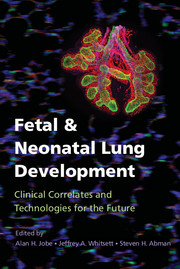Book contents
- Fetal and Neonatal Lung Development
- Lung Growth, Development, and Disease
- Fetal and Neonatal Lung Development
- Copyright page
- Contents
- Contributors
- Preface
- Chapter 1 The Genetic Programs Regulating Embryonic Lung Development and Induced Pluripotent Stem Cell Differentiation
- Chapter 2 Early Development of the Mammalian Lung-Branching Morphogenesis
- Chapter 3 Pulmonary Vascular Development
- Chapter 4 Transcriptional Mechanisms Regulating Pulmonary Epithelial Maturation:
- Chapter 5 Environmental Effects on Lung Morphogenesis and Function:
- Chapter 6 Congenital Malformations of the Lung
- Chapter 7 Lung Structure at Preterm and Term Birth
- Chapter 8 Surfactant During Lung Development
- Chapter 9 Initiation of Breathing at Birth
- Chapter 10 Perinatal Modifiers of Lung Structure and Function
- Chapter 11 Chronic Neonatal Lung Injury and Care Strategies to Decrease Injury
- Chapter 12 Apnea and Control of Breathing
- Chapter 13 Alveolarization into Adulthood
- Chapter 14 Physiologic Assessment of Lung Growth and Development Throughout Infancy and Childhood
- Chapter 15 Perinatal Disruptions of Lung Development:
- Chapter 16 Lung Growth Through the “Life Course” and Predictors and Determinants of Chronic Respiratory Disorders
- Chapter 17 The Lung Structure Maintenance Program: Sustaining Lung Structure during Adulthood and Implications for COPD Risk
- Index
- References
Chapter 13 - Alveolarization into Adulthood
Published online by Cambridge University Press: 05 April 2016
- Fetal and Neonatal Lung Development
- Lung Growth, Development, and Disease
- Fetal and Neonatal Lung Development
- Copyright page
- Contents
- Contributors
- Preface
- Chapter 1 The Genetic Programs Regulating Embryonic Lung Development and Induced Pluripotent Stem Cell Differentiation
- Chapter 2 Early Development of the Mammalian Lung-Branching Morphogenesis
- Chapter 3 Pulmonary Vascular Development
- Chapter 4 Transcriptional Mechanisms Regulating Pulmonary Epithelial Maturation:
- Chapter 5 Environmental Effects on Lung Morphogenesis and Function:
- Chapter 6 Congenital Malformations of the Lung
- Chapter 7 Lung Structure at Preterm and Term Birth
- Chapter 8 Surfactant During Lung Development
- Chapter 9 Initiation of Breathing at Birth
- Chapter 10 Perinatal Modifiers of Lung Structure and Function
- Chapter 11 Chronic Neonatal Lung Injury and Care Strategies to Decrease Injury
- Chapter 12 Apnea and Control of Breathing
- Chapter 13 Alveolarization into Adulthood
- Chapter 14 Physiologic Assessment of Lung Growth and Development Throughout Infancy and Childhood
- Chapter 15 Perinatal Disruptions of Lung Development:
- Chapter 16 Lung Growth Through the “Life Course” and Predictors and Determinants of Chronic Respiratory Disorders
- Chapter 17 The Lung Structure Maintenance Program: Sustaining Lung Structure during Adulthood and Implications for COPD Risk
- Index
- References
Summary
Alveolarization has been traditionally thought to be complete in the human lung by three to seven years of age. These estimates were based on traditional morphologic measurements from autopsy specimens. Recently new techniques have been used to estimate airway dimensions and alveolar size and numbers with aerosol deposition and hyperpolarized helium in living subjects. hyperpolarized helium measurements by magnetic resonance demonstrated increases in alveolar numbers until adulthood, a result that changes concepts about lung growth. Further, this technology applied to school-age children who had been premature infants with bronchopulmonary dysplasia demonstrated catch-up alveolarization. Application of new imaging technologies to different patient groups will likely change concepts about how the lung grows, repairs, and remodels with age.
- Type
- Chapter
- Information
- Fetal and Neonatal Lung DevelopmentClinical Correlates and Technologies for the Future, pp. 238 - 252Publisher: Cambridge University PressPrint publication year: 2016



